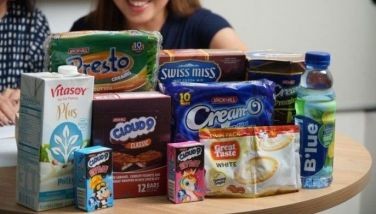Relevant research on relevant markets
January 12, 2004 | 12:00am
Big business always takes note of market share. Is this relevant to entrepreneurs? Student-entrepreneurs in AIM’s Master in Entrepreneurship program grapple with this issue all the time. One of them wryly commented that even if he were able to find out his market share, it will have too many zeroes after the decimal point. What he meant was that when the market share was calculated, the resulting number was so small and insignificant, something like 0.0000xxx%.
The point of the student-entrepreneur is valid if the total market (the denominator of the equation) considered the whole country as the market. But in entrepreneurship, there is such a thing as the relevant market. For consumer product/service-oriented entrepreneurs, the relevant market may be the effective area of influence. Thus, the first issue is defining the relevant market.
The next issue is determining how to measure or count the relevant market. Unlike big business which can refer to national and industry data to determine the market size, there is no such ready-made information on localized or small relevant markets.
For example, in the case of one student-entrepreneur in the photo processing enterprise, the relevant area is the local area of operations. She developed an innovative way to determine market demand patterns and market share. To her great surprise, she also found out that her chain of photo finishing stores has the largest market share in the relevant area. The important learning here is how she did her market analysis and how she will use the information to determine a marketing strategy.
Just because data is not readily available, does not mean that is cannot be generated. Armed with creativity and some funds, this student-entrepreneur used her knowledge of the practices of the industry to determine the patterns and volumes.
First, she defined that she will measure the number of photo finishing jobs as the basis of market size. Although the sales amount per job might differ, she knew that it would be too expensive to determine the exact peso amounts (relative to the value of the information). This is an important lesson. The cost of accuracy of market data must not exceed its value in determining strategies.
She made a simplifying decision that the distribution of the peso value of the transactions would not be too different from the experience in her stores. Thus, it was important to determine the number of and the daily patterns of transactions.
She also knew that there was an industry practice that made sure that there was a match between the film left for processing and the actual negatives and prints returned to the customer. This system was a set of consecutive pre-numbered labels. One is put on the film. The other matching number is put on the envelope where the prints will eventually be waiting to be claimed by the customer.
The design of the market data-gathering was also simple. Over a one-week period, she sent someone to have a roll of film processed to all photo finishers in the relevant area. She made sure that this film was brought into the store as soon as it opened. This meant that the film brought in was the first for the day. After doing this, the student would have seven different numbers (one for each day of the week) from all the photo finishers in the relevant area.
If one were to deduct the Tuesday number of a particular player in the market from the Monday number, this would yield the number of jobs that the particular player had on that Monday. If this were done for all the days of the week and from all players in the relevant area, the total number of jobs, the distribution per day and per player would be determined.
This process just shows that it is not difficult to determine market patterns and shares in a relevant area. One just has to be creative, innovative, and resourceful.
The value of the exercise to the student-entrepreneur is the resulting knowledge of how each of her stores performed against the other players in the market. Significantly, she found out that she was dominant in the relevant area. She also went one step further. She plotted the numbers against a map of the relevant area and discovered that there were clusters of photo finishers. They were either mall-based, commercial district-based, or stand-alones.
In addition, the unit price for identical photo processing jobs was plotted.
There was no relationship between price and volume of transactions. The lower price in the area did not have the highest volume of transactions. This discovery gave greater value to the information generated. Price was not the only factor that determined volume.
In another exercise called consumer analysis, this student-entrepreneur discovered that convenience and the availability of gloss prints were criteria considered by customers. But the gloss print was only important when the photo finishing stores were equally conveniently located. She discovered that the micro-market characteristics differed from one area to another.
The information generated was a significant cornerstone for generating strategic marketing options. Now, she has been able to generate strategies that are micro area-focused. In the areas where there were other players nearby, she has been able to identify which player is most vulnerable. One lesson to be learned here is that there is enough information when the winning strategy is obvious.
To summarize the lessons learned:
• make sure that the cost of gathering information is lower than the benefit;
• be creative in gathering information;
• use industry practices to device a way to extract information;
• convert data to strategic information; and
• enough information is gathered when the winning strategy is obvious.
(Alejandrino Ferreria is the dean of the Asian Center for Entrepreneurship of the Asian Institute of Management. For further comments and inquiries, you may contact him at: [email protected]. Published "Entrepreneur’s Helpline" columns can be viewed on the AIM website at http//: www.aim.edu.ph).
The point of the student-entrepreneur is valid if the total market (the denominator of the equation) considered the whole country as the market. But in entrepreneurship, there is such a thing as the relevant market. For consumer product/service-oriented entrepreneurs, the relevant market may be the effective area of influence. Thus, the first issue is defining the relevant market.
The next issue is determining how to measure or count the relevant market. Unlike big business which can refer to national and industry data to determine the market size, there is no such ready-made information on localized or small relevant markets.
For example, in the case of one student-entrepreneur in the photo processing enterprise, the relevant area is the local area of operations. She developed an innovative way to determine market demand patterns and market share. To her great surprise, she also found out that her chain of photo finishing stores has the largest market share in the relevant area. The important learning here is how she did her market analysis and how she will use the information to determine a marketing strategy.
Just because data is not readily available, does not mean that is cannot be generated. Armed with creativity and some funds, this student-entrepreneur used her knowledge of the practices of the industry to determine the patterns and volumes.
First, she defined that she will measure the number of photo finishing jobs as the basis of market size. Although the sales amount per job might differ, she knew that it would be too expensive to determine the exact peso amounts (relative to the value of the information). This is an important lesson. The cost of accuracy of market data must not exceed its value in determining strategies.
She made a simplifying decision that the distribution of the peso value of the transactions would not be too different from the experience in her stores. Thus, it was important to determine the number of and the daily patterns of transactions.
She also knew that there was an industry practice that made sure that there was a match between the film left for processing and the actual negatives and prints returned to the customer. This system was a set of consecutive pre-numbered labels. One is put on the film. The other matching number is put on the envelope where the prints will eventually be waiting to be claimed by the customer.
The design of the market data-gathering was also simple. Over a one-week period, she sent someone to have a roll of film processed to all photo finishers in the relevant area. She made sure that this film was brought into the store as soon as it opened. This meant that the film brought in was the first for the day. After doing this, the student would have seven different numbers (one for each day of the week) from all the photo finishers in the relevant area.
If one were to deduct the Tuesday number of a particular player in the market from the Monday number, this would yield the number of jobs that the particular player had on that Monday. If this were done for all the days of the week and from all players in the relevant area, the total number of jobs, the distribution per day and per player would be determined.
This process just shows that it is not difficult to determine market patterns and shares in a relevant area. One just has to be creative, innovative, and resourceful.
The value of the exercise to the student-entrepreneur is the resulting knowledge of how each of her stores performed against the other players in the market. Significantly, she found out that she was dominant in the relevant area. She also went one step further. She plotted the numbers against a map of the relevant area and discovered that there were clusters of photo finishers. They were either mall-based, commercial district-based, or stand-alones.
In addition, the unit price for identical photo processing jobs was plotted.
There was no relationship between price and volume of transactions. The lower price in the area did not have the highest volume of transactions. This discovery gave greater value to the information generated. Price was not the only factor that determined volume.
In another exercise called consumer analysis, this student-entrepreneur discovered that convenience and the availability of gloss prints were criteria considered by customers. But the gloss print was only important when the photo finishing stores were equally conveniently located. She discovered that the micro-market characteristics differed from one area to another.
The information generated was a significant cornerstone for generating strategic marketing options. Now, she has been able to generate strategies that are micro area-focused. In the areas where there were other players nearby, she has been able to identify which player is most vulnerable. One lesson to be learned here is that there is enough information when the winning strategy is obvious.
To summarize the lessons learned:
• make sure that the cost of gathering information is lower than the benefit;
• be creative in gathering information;
• use industry practices to device a way to extract information;
• convert data to strategic information; and
• enough information is gathered when the winning strategy is obvious.
(Alejandrino Ferreria is the dean of the Asian Center for Entrepreneurship of the Asian Institute of Management. For further comments and inquiries, you may contact him at: [email protected]. Published "Entrepreneur’s Helpline" columns can be viewed on the AIM website at http//: www.aim.edu.ph).
BrandSpace Articles
<
>
- Latest
Latest
Latest
February 21, 2025 - 9:00am
February 21, 2025 - 9:00am
February 13, 2025 - 12:00am
February 13, 2025 - 12:00am
January 30, 2025 - 4:05pm
January 30, 2025 - 4:05pm
January 27, 2025 - 11:00am
By Jay Ann Bonghanoy | January 27, 2025 - 11:00am
January 24, 2025 - 8:00am
January 24, 2025 - 8:00am
Recommended





























